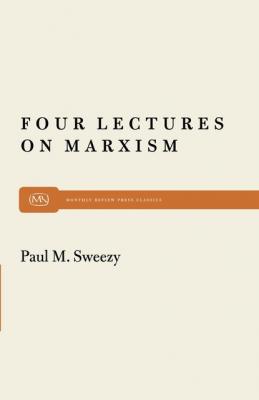Four Lectures on Marxism. Paul M. Sweezy
Читать онлайн.| Название | Four Lectures on Marxism |
|---|---|
| Автор произведения | Paul M. Sweezy |
| Жанр | Афоризмы и цитаты |
| Серия | Monthly Review Press Classic Titles |
| Издательство | Афоризмы и цитаты |
| Год выпуска | 0 |
| isbn | 9781583678282 |
Wherever the C—M—C circuit obtains, the first and last terms can be, and indeed normally are expected to be, quantitatively equal, i.e., to have the same exchange value. The rationale of the operation lies not in the realm of exchange value but in that of use value: for simple commodity producers, the C at the end has greater use value than the C at the beginning, and it is this increase in use value that motivates their behavior. Nothing of the sort exists in the M—C—M case. The first and last terms are both money, qualitatively homogeneous and lacking use value of its own. It follows that if the two M’s are also quantitatively equal, the operation totally lacks a rationale: no capitalist is going to lay out money and organize a process of production in order to end up with the same amount of money possessed at the outset. We can therefore rewrite the formula as M—C—M′ where M′ = M + ∆ M. Here ∆ M represents more money, or as Marx called it, surplus value (Mehrwert).
Before going any further we should ask where this surplus value comes from. Marx’s answer—and here he was following a line of reasoning pioneered by the classical economists, especially David Ricardo—was that the value of labor power (which he identified with the value of the worker’s means of subsistence) measured in hours of work is less than what the worker produces also measured in hours of work. Or, to put the point in other terms, that a part of the working day replaces the value of what the worker consumes, while the remainder of the working day produces surplus value. Thus if the working day is ten hours and it takes workers five hours to produce a value equivalent to their daily consumption, they will produce five hours’ worth of surplus value for the capitalist. Marx called the first five hours “necessary labor” and the second five hours “surplus labor,” and the ratio of surplus labor to necessary labor (in this case 100 percent) he called the “rate of exploitation” or, translated into value terms, the “rate of surplus value.” Note that, other things remaining equal, if the length of the working day is increased, the worker produces more surplus value for the capitalist and the rate of surplus value is raised. Marx called this the production of “absolute surplus value.” Conversely, and once again assuming everything else remains equal, if the productivity of workers is increased (through introduction of machinery, reorganization of the work process, speed-up) and the time required to produce their subsistence thereby reduced, the proportion of the working day devoted to necessary labor will fall and that devoted to surplus labor will rise. In this case too, the rate of surplus value will go up. Marx called this the production of “relative surplus value.”
Конец ознакомительного фрагмента.
Текст предоставлен ООО «ЛитРес».
Прочитайте эту книгу целиком, купив полную легальную версию на ЛитРес.
Безопасно оплатить книгу можно банковской картой Visa, MasterCard, Maestro, со счета мобильного телефона, с платежного терминала, в салоне МТС или Связной, через PayPal, WebMoney, Яндекс.Деньги, QIWI Кошелек, бонусными картами или другим удобным Вам способом.
